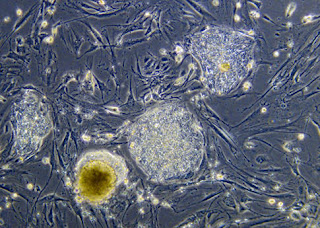So I'm feeling reenergised after SciBarCamb yesterday, very successful, more details to come. I've been storing a few posts up on my hard drive so I probably should get round to posting a few before the new term starts. Heres the first then, the results of an analysis of dubious 'stem cell treatments' which are taking advantage of the general public. Find out what is being done and how to protect yourself. Thanks for this one go to severa of my friends here in Cambridge who are big stem cell fans.
Stem cell technology has rapidly become one of the most well known recent advances in the biological sciences. They have excited many with the promise of cures for innumerable, common and debilitating diseases which affect millions worldwide. Stem cells have given hope to the hopeless, yet many are now taking advantage of this desperate hope for their own gain. False treatments are now everywhere, praying on severely ill patients and their families, with overblown promises of miracle recoveries and jargon-filled pseudoscientific literature which seem to support these sham therapies. These methods are often based upon obscure theories, which are not supported by proven, open, peer-reviewed evidence. This current situation not only threatens the patients who submit to these schemes, but is likely to significantly hamper advancement of legitimate research and the development of real, effective cures.
 |
| Cells being extracted from the early embryo for stem cell production (source) |
The report points out that many of these stem cell therapies charge patients extortionate amounts of money, this is unusual for any experimental therapy, which will usually be financially backed by government, research or commercial groups, interested in the safe and ethical development of new medical approaches. This is a key indicator of an unsupported scheme which could carry many potential hidden dangers. The ISSCR also recognises that, in order to address this problem, it requires the support of other organisations, including governments and scientific regulatory bodies.
 |
| New guidelines and resources are being established by the ISSCR (source) |
A lack of openness and unwillingness to share data and methodology is characteristic of questionable treatments that are best avoided. If a group is unwilling to discuss with others how it gained its results then they probably have something to hide. As such their findings, and claims, are probably scientifically unsound. This has all been clearly and precisely defined as a set of guidelines by the ISSCR, which stem cell studies should conform to in order to be considered scientifically valid and ethically safe.
The ISSCR task force has outlined, in detail, the process that it will follow to identify clinics offering stem cell treatments and to contact them and investigate the validity of their research. Their findings will be published for use by patients considering treatments, and will allow submission of new clinics for investigation. This resource would also be fully referenced and up-to-date, allowing further investigation of any group listed and ensuring information is always useful and relevant.
 |
| Embryonic stem cells in culture (source) |
The ISSCR has committed to “avoid overstating what is currently known, whether in the scientific domain, the clinical domain, or the commercial domain” and is working hard to ensure that the entire scientific community conforms to this promise. However, a lot of work is needed to implement all this, and questionable stem cell treatments are on the increase. For now, be cautious, whilst stem cell research is something to be supported and it holds a lot of potential, it is important to avoid being drawn into scams which are likely to leave patients even worse off than they already are.
Taylor, P., Barker, R., Blume, K., Cattaneo, E., Colman, A., Deng, H., Edgar, H., Fox, I., Gerstle, C., Goldstein, L., High, K., Lyall, A., Parkman, R., Pitossi, F., Prentice, E., Rooke, H., Sipp, D., Srivastava, A., Stayn, S., Steinberg, G., Wagers, A., & Weissman, I. (2010). Patients Beware: Commercialized Stem Cell Treatments on the Web Cell Stem Cell, 7 (1), 43-49 DOI: 10.1016/j.stem.2010.06.001
3 comments:
Hello,
Thanks for providing these useful tips over here. Stem cell treatments for multiple sclerosis has shown that it can be effective in treating, and even reversing...
When I gave birth to my son in may of 2010 I was explained by the doctor and nurses that the government took my son's Umbilical cord. When I asked the doctor why, he said "I am just a small fish in a big sea, its better you just forget about it." I haven't stopped thinking about it since. He was born in Rockford, Il. I need more explanation on this. It scares me to no end!
I'd like to know more about what it is that scares you about this. Whilst that is a very poor explanation that the doctors gave you, there really is nothing to be worried about and there is nothing sinister that scientists or anyone else can do with those cells.
The cells of the umbilical cord are very interesting because they have a lot of potential for growth and hence can be studied to understand how cells work. It's usually a really great way to get hold of a small number of human cells without causing any harm to anyone since the umbilical cord will normally die fairly quickly after birth anyway. Studies of umbilical cells can also be used to teach us a lot about developmental illnesses.
I hope you find this reassuring and would be happy to address your fears more specifically.
Post a Comment